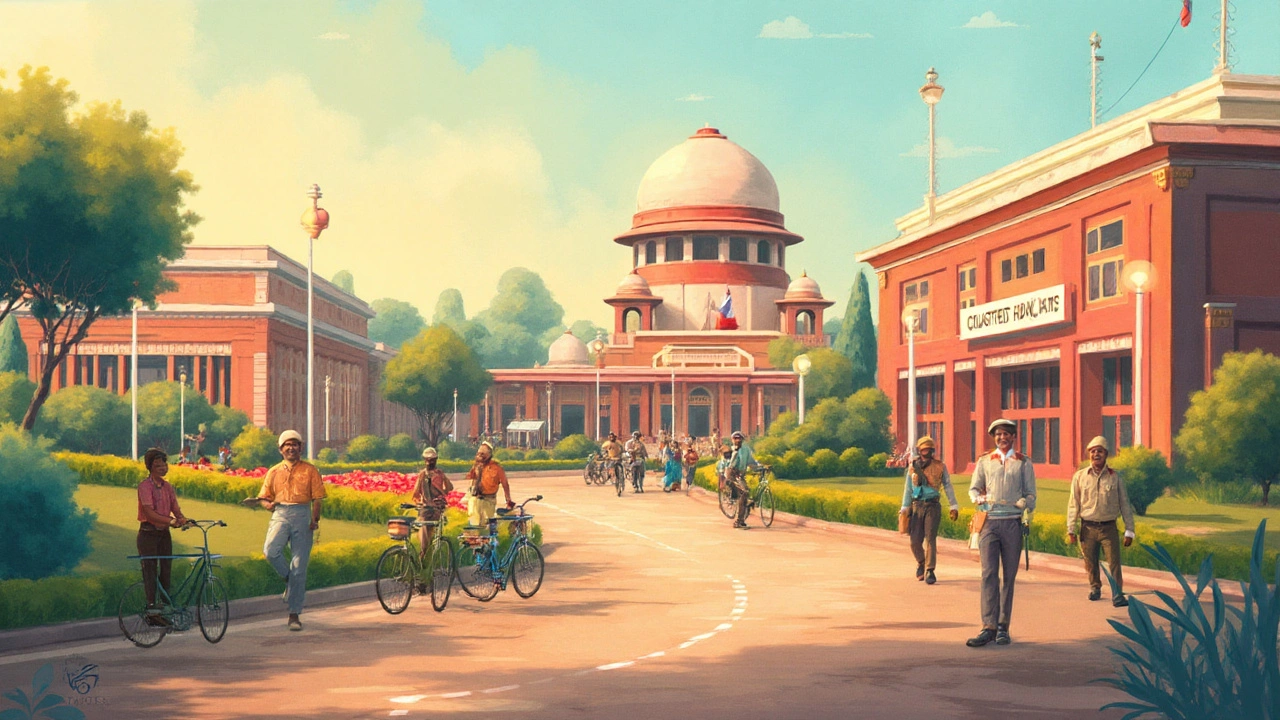Best Government Jobs: Where to Work for Benefits, Stability, and Growth

If I told you that the world’s happiest workers clock in at government offices, crazy, right? But here’s the twist: stats back it up. In 2023, nearly 70% of government workers in Nordic countries rated job satisfaction higher than their private sector buddies. Security, a steady paycheck, and benefits that make private firms drool have turned government gigs into the stuff of dreams for millions. But let’s be real—not all governments are created equal. Forget politics; we’re talking workplaces that value employees, offer insane perks, and give careers genuine meaning. If you’re wondering which government truly stands out and why, you’re about to get the inside scoop.
How Do Governments Stack Up as Employers?
It’s easy to imagine every government job means stuffy cubicles, endless rules, and burnt-out employees. That’s old news. These days, smart countries run the show like top-tier companies, dishing out benefits that rival big tech and banks. Scandinavia, for example, keeps popping up on every “Best Places to Work” list—not just because of the free coffee or the cozy office chairs. Their secret sauce? Work-life balance and employee trust.
Sweden, Norway, and Denmark invest heavily in professional development, offer extended parental leave, and allow parents to split time at home after a baby arrives. Think six weeks? Try six months—sometimes paid. Compare that to places where vacation time is a luxury rather than a right, and the difference is night and day. Take a look at annual paid leave:
| Country | Annual Paid Leave (Days) |
|---|---|
| Sweden | 25 |
| France | 30 |
| United States (Federal) | 13 to 26 |
| Japan | 18 |
| India (Central Govt) | 20 |
| Singapore | 14 |
But perks aren’t just about paid vacation or sick days. Some governments—like Canada’s federal service—give tuition support for degrees, free language training, mental health resources, and even fitness subsidies. And check this: The Canadian Public Service Employee Survey found 81% of their staff are “proud to work for their department.” For many, that sense of belonging beats a simple paycheck.
Let’s not leave out government workers in Singapore. Their civil service is famous for high starting salaries and transparent career ladders. Promotions are based on merit, with regular appraisals rather than old-school seniority. If you prove yourself, you move up. Simple as that. It’s a similar story in Germany, where “Beamte” (civil servants) have job security like no other—layoffs are almost unheard of, and even pensions are locked in.
But what about the stress? A 2024 report by the International Labour Organization showed government jobs, on average, score lower on the “high-stress” index compared to private corporate roles. Sure, there are exceptions—first responders or diplomats face tough days. But most government jobs in departments like education or research offer a steadier pace, less uncertainty, and a healthier environment.
Let’s not forget inclusivity. Australia’s public sector leads in hiring employees with disabilities, while the UK’s Civil Service Fast Stream runs programs for recruiting minorities and underrepresented groups. The message is clear: if it’s equality you’re after, government offices are ahead of most private rivals.

Top Governments to Work For: What Sets Them Apart?
If you want to know who’s topping the charts, it’s a close race between progressive European states, dynamic Asian economies, and a handful of North American heavyweights. But here’s what separates the best from the rest.
Let’s talk about Finland. It didn’t just rank #1 in the 2024 World Happiness Report out of habit—its government offices are a huge reason why. Civil servants get flexible hours, support for remote work, and wellness programs that feel ripped from a Silicon Valley startup. There are team-building retreats, nap lounges, and generous healthcare. Employees say supervisors actually listen, and the notorious Finnish trust goes both ways: managers give teams freedom to innovate, which isn’t something you’ll hear everywhere.
New Zealand’s government is another rising star. Besides offering solid pay, public servants can work compressed workweeks (imagine four days on, three days off—without salary cuts). This model exploded post-pandemic and stuck because workers got more done in less time. The Kiwis weren’t content stopping there—annual “wellbeing budgets” directly invest in staff mental health, and the public workforce has one of the lowest turnover rates globally. This translates to deep expertise within departments and more stable careers.
France might conjure images of endless strikes, but here’s a surprise: job security in the French civil service is unmatched. Even during economic downturns, layoffs are rare, and promotions come with time and training. Civil servants benefit from subsidized transportation, rent support, and early retirement plans. No wonder French administration jobs get nearly 400,000 applicants each exam cycle—a stat pulled from their own National School of Administration reports.
In Asia, Singapore and South Korea are the studs of public sector innovation. Singapore’s “Public Service for the 21st Century” (PS21) movement introduced tech-driven workplaces, encouraged feedback from ground-level staff, and designed a fast-track system for outstanding talent. Promotions, training grants, and overseas postings are routine. In South Korea, government scientists earn pay on par with the private tech sector, and development projects regularly scoop up innovation awards—proof that you don’t have to ditch your ambition for a public paycheck.
And don’t skip over Canada and Australia—they round out every list of “friendliest workplaces” for government employees. Australia’s departments offer more part-time roles, flexible parental leave, and upskilling courses (even during work hours). Canadian public servants join employee-led networks, sit on hiring panels, and run in-office volunteering programs. There’s a sense you’re shaping your own job, not just punching the clock.
| Country | Average Monthly Government Salary (USD, 2024) |
|---|---|
| Singapore | 4,000 |
| Canada | 3,800 |
| Sweden | 3,700 |
| United Kingdom | 3,500 |
| India | 900 |
Is there a downside? Sure—red tape can frustrate, promotion may take time in more traditional systems, and you’ll deal with some level of bureaucracy. But when you weigh in the benefits, security, and meaning, it’s easy to see why the public sector keeps attracting top grads and pros alike.

How to Land a Government Job: Insider Tips and Surprising Facts
All this sounds great, but you’re probably wondering: how do you actually snag one of these jobs? It starts with the right mindset. Gone are the days when just cramming for an entrance test could make you a shoo-in. Today, the most competitive governments want tech-savvy, adaptable, people-focused recruits. Getting your foot in the door means knowing what each government values most—and playing to those strengths.
In places like the UK or Canada, internships and student placements carry serious weight. These entry programs often turn into full-time offers, and they let you build connections while learning how the sausage (or public policy) gets made. In Scandinavia and Germany, career fairs and open days let you quiz current employees about their routes in. Don’t forget social media—countries like Australia post openings and talk culture on LinkedIn, Twitter, and Facebook, so following the right pages gives you a jump on new roles.
Here’s a quick breakdown of what the top governments usually look for:
- Best government to work for offices prioritize soft skills. Communication and teamwork come up in almost every interview or assessment center. Brush up on group activities and scenario-based questions.
- Digital literacy is key. Don’t just list “Excel” on your resume—show off your ability to use collaboration tools, manage data, or present findings.
- Languages open doors. In Switzerland, Canada, and India, knowing more than one official language puts you on the fast track.
- Volunteer or community experience counts as much as grades, especially for local government jobs.
Worried about the dreaded civil service exams? Prep has gone high-tech. Mock online tests, interactive video interviews, and gamified simulations are part of modern hiring. For something like Singapore’s Public Service Leadership Program, you might solve real-life case studies as part of the selection, not just fill in multiple-choice sheets.
And what about after you get the job? Be ready for a different pace from the private sector. Onboarding is longer (sometimes months), training is constant, and mobility is encouraged. In Sweden, rotating between ministries is common—instead of one career path, you get to sample many during your tenure. In France, internal competitions let you switch streams, so you’re not stuck in one role forever.
Here are some smart tips for standing out:
- Tailor your resume and cover letter to show public service motivation. Governments like to see you’re genuinely interested in helping society, not just chasing a steady paycheck.
- Prepare for assessments beyond knowledge—stress test your decision-making and problem-solving skills.
- Show you’re curious about new tech and methods.
- Build your network early. Attend info sessions, public lectures, and webinars—sometimes these even have exclusive “fast track” spots for attendees.
Sure, government hiring scans for rules and transparency, but don’t be afraid to show personality and drive. After all, the best governments to work for want people who’ll shape the next chapter—not just follow the current script.

